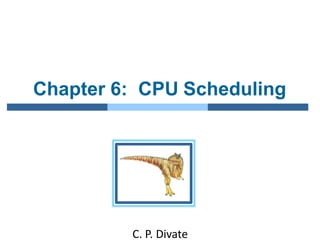Chapter 6 discusses CPU scheduling, its algorithms, and criteria for effective operation in multiprogrammed systems. It covers various scheduling methods including First-Come, First-Served, Shortest Job First, Priority Scheduling, and Round Robin, along with their advantages and complications like starvation and context switching. The chapter also addresses complexities in multiprocessor scheduling and real-time scheduling requirements, emphasizing the importance of algorithm optimization and performance evaluation.


















![Example of Shortest-remaining-time-first
● Now we add the concepts of varying arrival times and preemption to
the analysis
Process Arrival Time Burst Time
P1 0 8
P2 1 4
P3 2 9
P4 3 5
● Preemptive SJF Gantt Chart
● Average waiting time = [(10-1)+(1-1)+(17-2)+5-3)]/4 = 26/4 = 6.5 msec
6.19](https://image.slidesharecdn.com/ch6-240509101931-6625e6c4/85/Operating-Systems-CPU-Scheduling-Process-19-320.jpg)













![Pthread Scheduling API
6.33
#include <pthread.h>
#include <stdio.h>
#define NUM_THREADS 5
int main(int argc, char *argv[]) {
int i, scope;
pthread_t tid[NUM THREADS];
pthread_attr_t attr;
/* get the default attributes */
pthread_attr_init(&attr);
/* first inquire on the current scope */
if (pthread_attr_getscope(&attr, &scope) != 0)
fprintf(stderr, "Unable to get scheduling scopen");
else {
if (scope == PTHREAD_SCOPE_PROCESS)
printf("PTHREAD_SCOPE_PROCESS");
else if (scope == PTHREAD_SCOPE_SYSTEM)
printf("PTHREAD_SCOPE_SYSTEM");
else
fprintf(stderr, "Illegal scope value.n");
}](https://image.slidesharecdn.com/ch6-240509101931-6625e6c4/85/Operating-Systems-CPU-Scheduling-Process-33-320.jpg)
![Pthread Scheduling API
6.34
/* set the scheduling algorithm to PCS or SCS */
pthread_attr_setscope(&attr, PTHREAD_SCOPE_SYSTEM);
/* create the threads */
for (i = 0; i < NUM_THREADS; i++)
pthread_create(&tid[i],&attr,runner,NULL);
/* now join on each thread */
for (i = 0; i < NUM_THREADS; i++)
pthread_join(tid[i], NULL);
}
/* Each thread will begin control in this function */
void *runner(void *param)
{
/* do some work ... */
pthread_exit(0);
}](https://image.slidesharecdn.com/ch6-240509101931-6625e6c4/85/Operating-Systems-CPU-Scheduling-Process-34-320.jpg)














![POSIX Real-Time Scheduling API
6.49
#include <pthread.h>
#include <stdio.h>
#define NUM_THREADS 5
int main(int argc, char *argv[])
{
int i, policy;
pthread_t_tid[NUM_THREADS];
pthread_attr_t attr;
/* get the default attributes */
pthread_attr_init(&attr);
/* get the current scheduling policy */
if (pthread_attr_getschedpolicy(&attr, &policy) != 0)
fprintf(stderr, "Unable to get policy.n");
else {
if (policy == SCHED_OTHER) printf("SCHED_OTHERn");
else if (policy == SCHED_RR) printf("SCHED_RRn");
else if (policy == SCHED_FIFO) printf("SCHED_FIFOn");
}](https://image.slidesharecdn.com/ch6-240509101931-6625e6c4/85/Operating-Systems-CPU-Scheduling-Process-49-320.jpg)
![POSIX Real-Time Scheduling API (Cont.)
6.50
/* set the scheduling policy - FIFO, RR, or OTHER */
if (pthread_attr_setschedpolicy(&attr, SCHED_FIFO) != 0)
fprintf(stderr, "Unable to set policy.n");
/* create the threads */
for (i = 0; i < NUM_THREADS; i++)
pthread_create(&tid[i],&attr,runner,NULL);
/* now join on each thread */
for (i = 0; i < NUM_THREADS; i++)
pthread_join(tid[i], NULL);
}
/* Each thread will begin control in this function */
void *runner(void *param)
{
/* do some work ... */
pthread_exit(0);
}](https://image.slidesharecdn.com/ch6-240509101931-6625e6c4/85/Operating-Systems-CPU-Scheduling-Process-50-320.jpg)




















